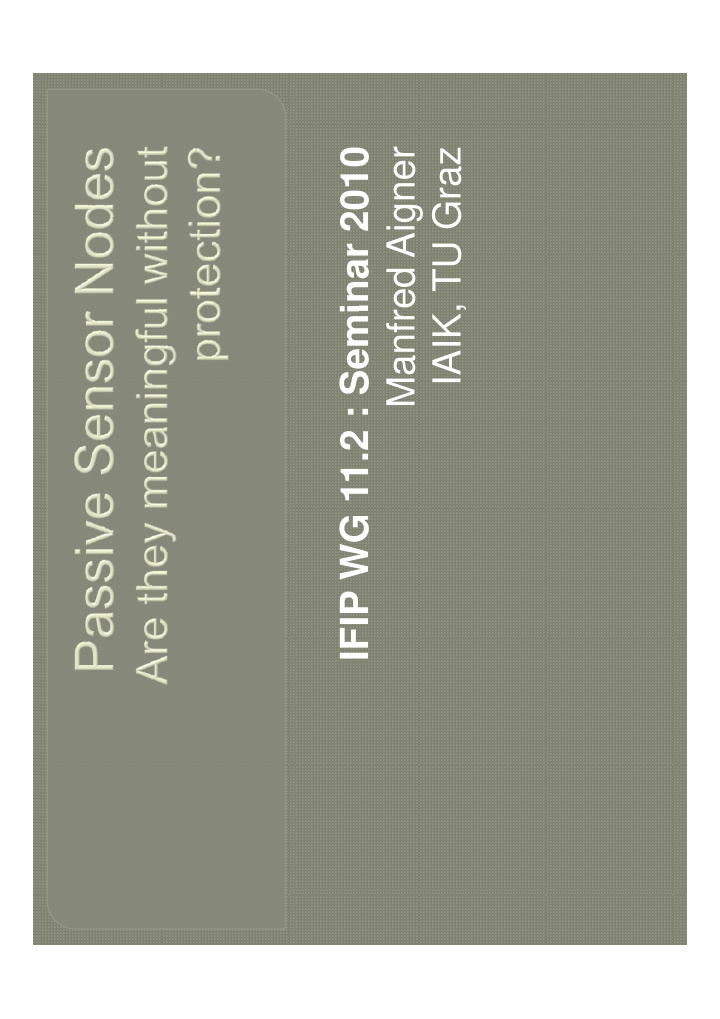



IFIP WG 11 2 : Seminar 2010 IFIP WG 11.2 : Seminar 2010 Manfred Aigner IAIK TU Graz IAIK, TU Graz
BRIDGE project: Sensor-enabled RFID tag handbook ToC: • Introduction • State of the art • Wireless sensor data communication • Features and Requirements of sensor enabled RFID tags • Ambient intelligence with sensor-enabled RFID tags • Real life pilot project with sensor enabled tags
Passive or semi-passive RFID communication principle RFID communication principle (reader triggered) Low cost Low cost – high volume tags high volume tags Simple controller on board Compatible with available C tibl ith il bl RFID reader infrastructure also NFC UHF and HF
SL900A Datasheet EPC Class 3 Chip with Sensor … is an Security features mentioned: EPC Class 3 tag chip …track, monitor, EPC Class 3 tag chip …track, monitor, Chapter 6.10 Data Protection (of time-stamp and record information SL900A) about any goods in any supply chain or Additional to the Gen2 lock protection, [..] cold chain transport. …healthcare and environmental supervision… i t l i i offers read/write protection using 3 ff d/ it t ti i 3 Description: password sets for 3 memory areas. Each .. in semi-passive mode … as well as in 32-bit password is divided into 2 16-bit fully passive mode. fully passive mode. passwords, where the lower 16 bits are passwords where the lower 16 bits are Key Features: reserved for the Write protection and the Frequency: 860 to 960 MHz (UHF) higher 16 bits are reserved for the Data logging from: Read/Write protection Read/Write protection. On-chip temperature sensor External sensors On-chip 9k-bit EEPROM Anti-collision capability p y Pictures & data taken from product‘s webpage
DatasheetA - Datasheet B D t h tA D t h t B GT-301: Overview • Available either as passive or battery assisted logging • Available either as passive or battery-assisted logging sensors • Wireless temperature sensing combined with unique ID ID • Standard industrial sensing range from –20 ºC up to +60 ºC ±0.5 ºC • Custom 0.1 ºC technology available (diagnostics) • HF 13.56 MHz ISO 15693 compatible No security features described Pictures & data taken from product‘s webpage
Datasheet: Versatile A/D interface for resistive sensors V til A/D i t f f i ti ISO-15693 13.56MHz transponder Slave / Master SPI interface 4 k-bit EEPROM with access protection O Standalone data-logging mode Ultra low power Battery or battery-less applications Security mentioned: y The user data are separated in 8 pages, whose access levels (L0 to L3) are defined thanks to 2 bits, stored inthe ‘ Security Map Register’ of the EEPROM. A security procedure based on a password is required to execute the unlocking The password is stored in required to execute the unlocking. The password is stored in EEPROM #06 (16 bits ~ page 24). Pictures & data taken from product‘s webpage
Temperature Logger: Semi passive Logger A927Z: RT0005 – EPC C1G2 (ISO18000-6C) Compatible • Highlights EPC C1G2 (ISO18000- – Frequency range: 860 MHz ÷ 928 Frequency range: 860 MHz 928 6C) Compatible 6C) Compatible MHz • Frequency range: 860 MHz ÷ 928 – Read range: approx. 10m in air MHz (2.5m on metal) @ 2W ERP (2 5m on metal) @ 2W ERP • Read range: approx. 10m in air Read range: approx 10m in air – Unique ID plus long EPC code (512 (2.5m on metal) @ 2W ERP bit) • Unique TID plus long EPC code – Memory capacity: 8k samples (16 Memory capacity: 8k samples (16 (512 bit) (512 bit) kbyte) • Memory capacity: 4k samples (8 – Programmable sampling interval kByte) – Programmable temperature • Multiple programmable sampling thresholds interval – Battery life: 3 or 5 years • Multiple programmable temperature thresholds – Battery charge measurement through RF Pictures & data taken from product‘s webpage
Central server with application (e.g. cold C t l ith li ti ( ld chain surveillance) Fact: Tag travels in unprotected/non trusted Fact: Tag travels in unprotected/non-trusted zone A.) Tag enters trusted zone to be read out A.) Tag enters trusted zone to be read out B.) Tag sends its data via a trusted reader through internet to server C.) Tag sends its data via non trusted reader C ) T d it d t i t t d d to server D ) Tag never leaves trusted zone (useless D.) Tag never leaves trusted zone (useless for many applications)
The shipping warehouse? The delivery service? The delivery service? The receiving warehouse? It depends who checks the sensor‘s data!
E.g. a sleazy trucker wants to hide his failure before delivering the goods … failure before delivering the goods …
Guess password (16 bit passwords!!) Spoof password when tag operates with Spoof password when tag operates with reader Read data out Read data out Modify data after reading Modify data when stored on the sensor M dif d t h t d th DPA (still an overkill) Fault attacks (what for?)
Healthcare (Fever measurement, Temperature monitoring of medical products) p g p ) Cold chain monitoring and tracking Asset management and monitoring (security Asset management and monitoring (security and integrity), Pharmaceutical logistics Building automation Building automation Industrial, medical and residential control and monitoring monitoring Dynamic Shelf Life applications
Raise awareness of protection in sensor community community Analyze possible use cases Develop and suggest protection concepts Develop and suggest protection concepts that fit to applications, assuming that tags t travel in non trusted areas l i t t d
WISP – Wireless Sensor Platform from Intel labs Intel labs
ISO/IEC/IEEE WD 21451.7 Information technology — Smart Transducer Interface for Sensors and Actuators for Sensors and Actuators — Transducers to Radio Transducers to Radio Frequency Identification (RFID) Systems Communication Protocols and Transducer Electronic Communication Protocols and Transducer Electronic Data Sheet Formats … suggests AES for authentication and encryption of sensor data.
Recommend
More recommend